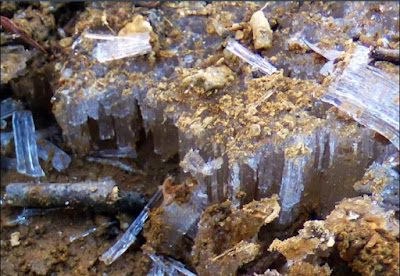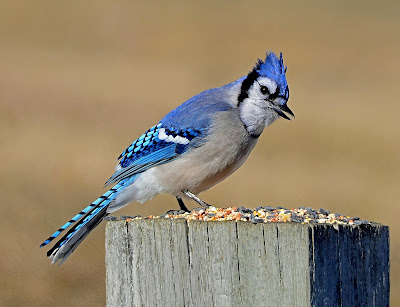Nature News: Needle ice a sure sign winter is coming
 |
| Needle ice pushing up through the soil by Sue Pike |
Finally! A little snow and frosty mornings ...; winter is coming! One of my favorite first signs of winter recently happened - the ground was crunchy underfoot.
Little frozen spikes (called needle ice) had erupted out of the earth, pushing up the dirt and loosening the soil. After delightedly crunching through my first needle ice of the winter, I picked up and sifted through the remnants. The ice needles were all about the same length (approximately 4 centimeters) and width (thin - maybe a couple millimeters) and all oriented in the same direction. This beautiful perfection was the result of our recent cold nights. Other names for these little needles are frost pillars, frost columns, comb ice or, my favorite, "pipkrake" from the Swedish "pipa" meaning tube and "krake" for weak or fine.
Needle ice is just one of the many things that can happen when water freezes. It requires the same conditions as frost formation but isn't the same as frost. Frost forms when it is cold enough for water vapor in the atmosphere to deposit onto a surface as an ice crystal. Needle ice comes from water in the ground. For needle ice to form, the conditions have to be just right - wet, unfrozen soil and freezing temperatures. When temperatures drop below freezing, water begins to freeze near the surface of the soil. As the water freezes, it pulls more water toward it through capillary action. As this ice freezes, it expands, pushing these needles up out of the soil.
Our forests are one of the perfect places to look for needle ice. In addition to the right amount of soil moisture and air temperature, needle ice formation also requires a soil texture that has enough pore space to be able to pull water to the surface to feed the needles, but that also has small enough grain size to hold the water in place against the pull of gravity. Sandy soils won't work ...; instead soils with clay and silt, the rich loamy soils of our forests, are perfect.
Needle ice isn't just good-looking, it can change landscapes. According to the National Snow and Ice Data Center, needle ice plays an active role in loosening soil for erosion and tends to move small rocks upward to the soil surface. Needle ice formation gives you a glimpse into the forces that underlie frost heaving, a phenomenon that concerns all of us who drive on roads in the Northeast. The same process that allows needle ice to form (a process called ice segregation) is also responsible for frost heaves. Frost heaves originate deeper down in the soil where freezing water pulls liquid water from the surrounding soil, concentrating the water into lens-shaped regions of ice. As the water contributing to the ice lens freezes, it expands and pushes up on the overlying soil (or road) causing a frost heave.
These little things, the frost on our window panes, the needle ice underfoot, the nip in the air are all what make living in New England so wonderful. Each season has its signature and as with every other facet of the natural world around us, learning to see these changes - for example to recognize needle ice for what it is and means - brings a deeper understanding and appreciation to our lives.
Susan Pike, a researcher and an environmental sciences and biology teacher at St. Thomas Aquinas High School, welcomes your ideas for future column topics. She may be reached at spike3116@gmail.com. Read more of her Nature News columns online.



Comments
Post a Comment